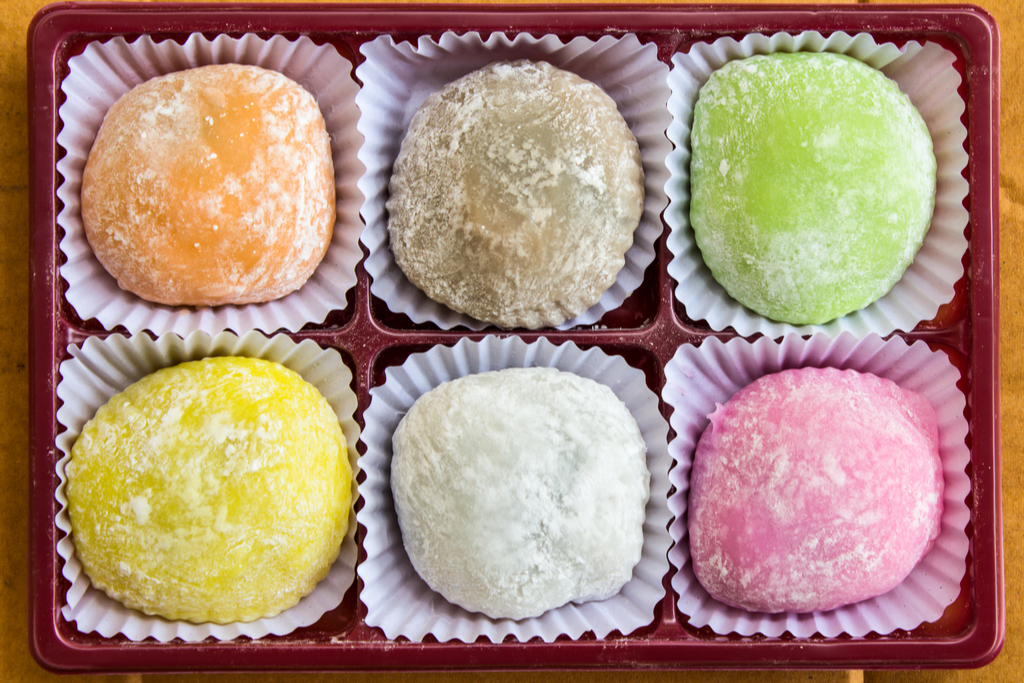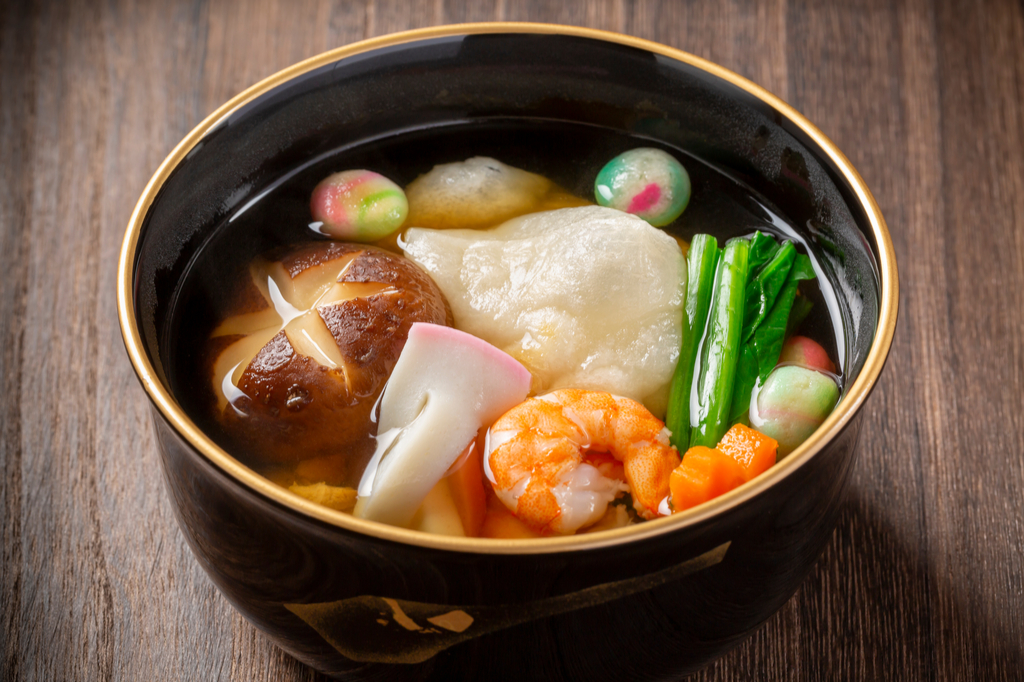dango, japanese new year's, mochi, mochitsuki, rice, wagashi
Mochi History: Trivia, Facts & How to Make It!
Jenna Wilson
Posted on June 30, 2021
Share:

Mochi history covers the culinary tale of a popular Japanese treat made by pounding glutinous rice into a sticky dough. This sweet and versatile delicacy is enjoyed in a variety of forms, including traditional sweet fillings like red bean paste and sweetened chestnut, as well as modern variations like ice cream and chocolate.
It is a staple during special occasions and celebrations, such as weddings and New Year’s, and is also enjoyed as a snack or dessert year-round. With its unique texture and flavor, mochi has become a beloved treat in Japan and beyond.
Where did mochi originate?
Mochi has been a part of Japanese culture since the Jomon period (14,000-300 BCE), when rice cultivation became widespread in Japan. However, in the Nara period (710-794 CE), mochi began to resemble the treat we know today.
During the Heian period (794-1185 CE), mochi became popular among the aristocracy, and people served it during special occasions and celebrations. By the Edo period (1603-1868), mochi had become a staple food in Japan, and various regional variations had developed.
Traditional mochi-making involves pounding cooked glutinous rice with wooden mallets until it forms a sticky and elastic dough. This process is known as mochitsuki, which people perform during special events and festivals.
Today, mochi is enjoyed in many forms and has become a popular treat worldwide. Its unique texture and sweet taste make it a beloved snack and dessert for people of all ages.
Mochi History in Japanese Culture
When mochi was first introduced to the West, people initially called it “Japanese Rice Cake”. However, thanks mainly in part to social media, the word mochi has since entered the English language. And for the anime generations, the word is almost as ubiquitous as other Japanese loanwords like sushi, sake, or kimono.
Chewy, savory, sweet, or in between, Japanese mochi has a long history and is integral to many traditions and rituals. It was a way to unite people, mark a celebration, and even show off your status. But what is mochi exactly, and how do people make it?
Mochitsuki: How to Make Mochi

The process of creating mochi, or mochitsuki (which literally means “pounding mochi”), starts with short-grain glutinous rice, or mochigome, and is typically associated with the New Year’s holiday. Unless you are a skilled mochi maker, a team is required to complete this time-consuming and physically demanding task. Before being measured and formed into individual servings, the mochi is soaked and then heavily pounded with wooden mallets.
Making mochi is a multi-day process that involves preparation, pounding, shaping, and serving. Despite its labor-intensive nature, people love this hobby, similar to Christmas baking. Japanese communities and families take great pride in their homemade meals, which can be frozen and enjoyed throughout the year. Although mochi is readily available year-round at supermarkets, convenience stores, and specialty shops, homemade mochi is superior in taste.
Interested in trying mochi? Would you like to enjoy even more of mochi history? Experience delightful tastes & textures from Sakuraco – a teatime experience from Japan to your home.
Ozoni: A Japanese New Year’s Tradition with Mochi History

Although kagami mochi, the two-tiered mochi decoration with a mandarin on top, is gaining awareness abroad, a perhaps lesser-known New Year’s mochi culinary tradition is ozoni. This soup has mochi, vegetables, and miso or soy sauce stock. People enjoy it duing the holidays alongside osechi, another dish reserved for the beginning of the year.
Ozoni has been a traditional New Year’s Day dish in Japan for over 500 years and was first enjoyed by samurai as a first dish to a ritual meal. Because of this long history, there are countless versions based on regionality. Eastern and Western Japan are standard culinary divisions, but this soup can vary even to the prefecture!
During the New Year’s holiday, relaxing and spending time with family is essential, so people make their dishes far in advance. Ozoni, however, is a straightforward and humble dish, so it’s not unusual for the whole family to work together to make and customize this delicious soup. After creating a rich broth and then adding toasted mochi, chicken, and vegetables, the sky’s the limit with this holiday favorite.
Wagashi: A Sweet Part of Mochi History

When people enjoy mochi overseas, it is often in the form of daifuku, a mochi with a sweet filling. However, daifuku is one of many Japanese desserts or “wagashi”. “Wa” means “Japan,” and “gash” means “candy” or “dessert”.
When Japan was still in isolation, there was minimal trade with other countries and in turn minimal access to other ingredients. This is why many Japanese sweets are based around the same flavor palette of sweet azuki beans, sesame, and chestnut. Despite these limitations, many variations of wagashi and confectionery shops across the country still employ historical production methods.
Some notable mochi-based wagashi include sakura mochi, daifuku, and mochi ice cream. All of these dishes play a role in Japanese mochi history.
What is Dango?
In the famous Japanese folktale called Momotaro (Peach Boy), a boy is born in a peach and embarks on a quest to save his village from a group of terrible trolls. Before beginning his adventure, his mother provides him with kibidango, a food made with rice flour and water that is commonly eaten by ordinary people to keep them strong.
Dango is a humble wagashi that people make by rolling rice flour and water into small balls, which they can then steam or grill and flavor with various dipping sauces or toppings. Like bread in Western stories, dango is in folktales because it was a common food that people eat. With endless flavor and color options, dango is versatile and suits different tastes. It is a popular Japanese street food many enjoy throughout the year at festivals.
A Modern Twist: Mochi + Ice Cream

Although dairy is a recent addition to the Japanese diet, Japan found creative ways to adapt it to local tastes. One fun example is mochi aisu, or mochi ice cream, which is popular in countries worldwide.
The dessert was first offered in vanilla, chocolate, strawberry, and traditional Japanese flavors. However, Japanese companies now regularly release new limited-edition and seasonal flavors that range from delightful to straight-out wacky.
The number one mochi ice cream company in Japan, Yukimi, is famous for continually delighting the public with its creative flavors which is available at most convenience stores and supermarkets. From tiramisu to pudding and black sesame to durian, there’s certainly something for everyone!
Which flavor are you? Take our quiz to find out!
Donut Miss This

A staple in Japan, it’s hard to believe that the first Mister Donut only opened in 1971. Nowadays, donuts aren’t an exotic Western dessert but a sweet treat or cheeky breakfast.
But thanks to the rise of Instagram, one particular menu item has seen a meteoric rise in popularity: the Pon de Ring “Mochi Donuts”.
The chef makes these donuts with rice flour to create a unique mochi mochi texture that appeals to the Japanese palate. They form the ring by using eight balls of dough, giving the desserts a unique and Insta-worthy appearance. Diners can also individually pull each ball for a richer culinary experience.
These donuts have been around for years, but they’re still popular and grabbing headlines because Mister Donut is constantly pushing the boundaries. They play around with flavors and partner with big brands for limited releases, such as Pokémon, and well-renowned Confectionery Companies, such as Mochi Cream Japan.
The Future of Mochi?
With more and more Japanese people moving to the city for work, local events like mochitsuki are falling out of favor, and some worry that mochi history might be lost forever. But, even though mochi isn’t handmade these days, this does not mean younger generations no longer want to make it themselves.
Homemade mochi is still a thing; though they usually come from a factory these days. Like many technological advancements, there are always going to be growing pains. But there’s something extraordinary about allowing people to enjoy fresh mochi at the click of a button.
Have you tried any of these types of mochi? How did you like the texture? Were you familiar with mochi history before? Let us know in the comments below!

Discover authentic flavors with Sakuraco
Get Sakuraco 
2 Responses

Discover authentic flavors with Sakuraco
Get Sakuraco 
Related Articles

Mount Fuji Snacks That You Need to Try This Summer!
Mount Fuji, Japan’s highest and most iconic peak, has long served as a muse not just for artists and poets, but also for confectioners. Its symmetry and snow-capped grandeur make it an ideal motif for culinary artisans nationwide. These treats capture the spirit of Fuji in edible form, reflecting regional ingredients, seasonal symbolism, and time-honored techniques.

Okinawa City is Home to Southeast Botanical Gardens!
The Southeast Botanical Gardens in Okinawa are one of the island’s most beautiful and relaxing destinations. In Okinawa City, they offer a lush escape filled with tropical plants, ponds, animals, and seasonal displays.

Mount Fuji Tour: Great Adventures Await You This Summer!
Mount Fuji is one of the most famous landmarks in Japan. People worldwide visit to see its beauty and enjoy exciting yearly outdoor activities!

Mikoshi: Why Are These Portable Shrines So Important?
Japan’s summer festivals are known for their energy, color, and tradition. And at the heart of many lies the mikoshi.




The mochi is often my favorite part of each Sakura box, I’ve really been enjoying the variety if types I’ve received. Is there any chance we might be able to get nama yatsuhashi in a future box?
Glad to hear you’re really enjoying the mochi selection.
We’ll keep nama yatsuhashi in mind, you never know what may pop up in the future!